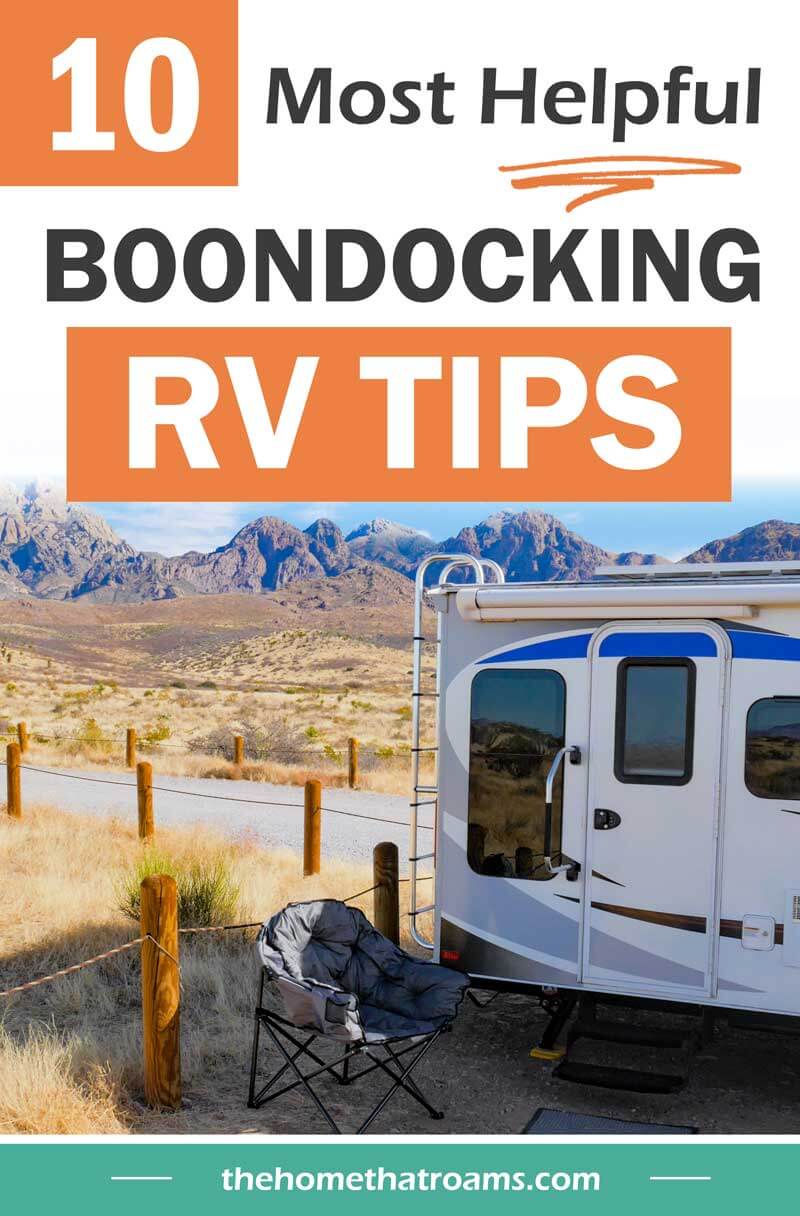10 Essential Tips for Boondocking in an RV
As an Amazon Associate, we earn from qualifying purchases. We also earn from other affiliate websites. See our full disclaimer.
When you’re getting started boondocking, it can be intimidating, and many RVers are even afraid to try it. We’re here to show you that it doesn’t have to be so hard, and with this helpful guide, you can quickly get started.
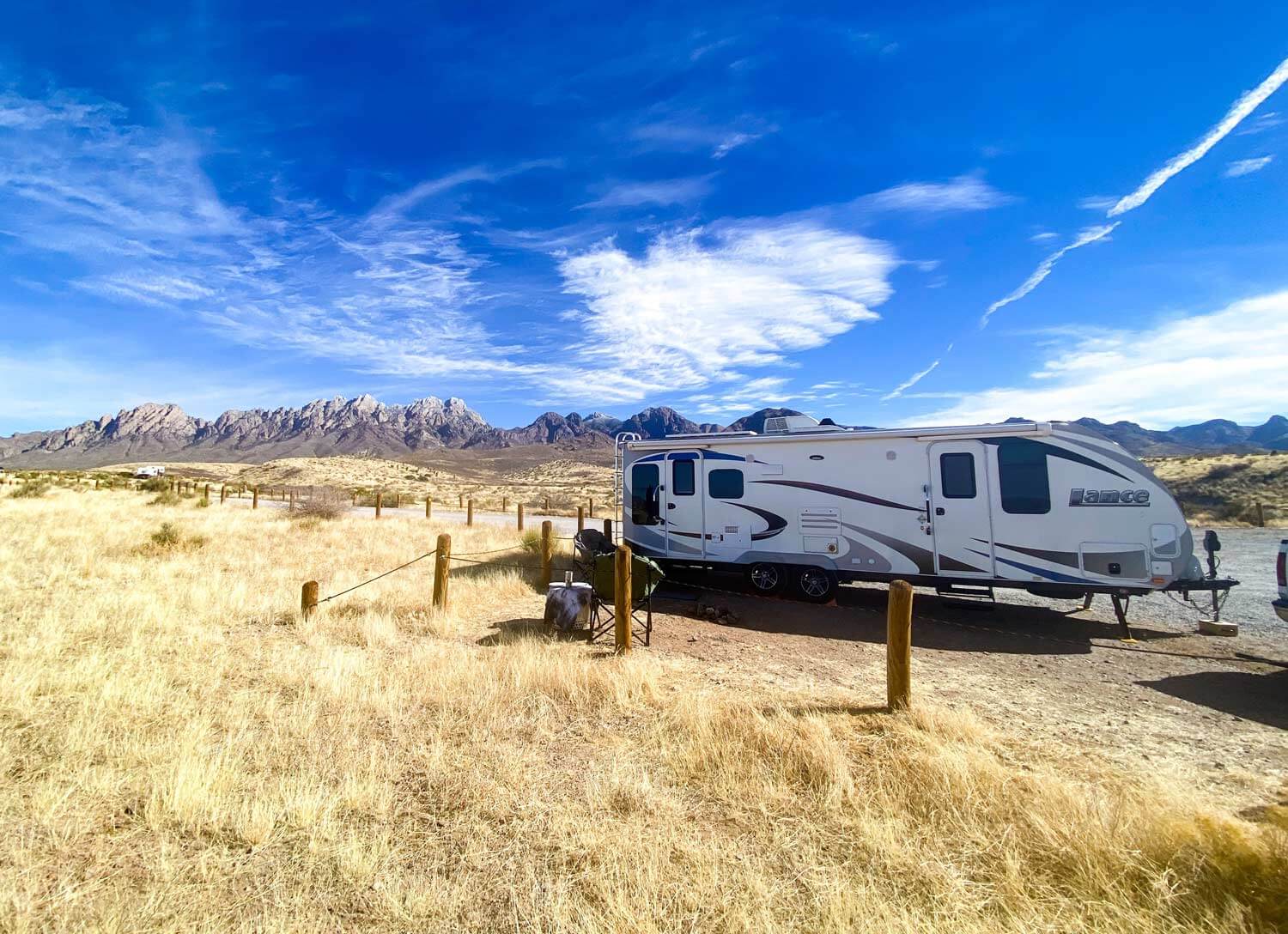
Below, we’ll offer tips for boondocking for beginners, including keeping your water tanks full, ensuring you have enough battery power, and what to expect when you’re camping off-grid.
Here are ten RV boondocking tips to prepare you for camping in the wild!
What is Boondocking?
Boondocking is often used interchangeably with dry camping. However, dry camping is more like what you do when you park overnight at stores like Walmart or Cracker Barrel. You don’t have hookups, which is why it’s “dry,” but you aren’t out in the wild, as boondocking implies. Boondocking is typically off-grid RV camping.
Most boondocking locations (especially in the western U.S.) are BLM land, also known as Bureau of Land Management land. These areas are accessible to campers for a limited number of days (14 days in a 28-day period). Here is detailed clarification on the 14-day BLM boondocking rule.
1. Know Your Power Supply
When you don’t have shore power (connected power) for days or weeks, you’ll need a solution for running the electrical system in your RV.
How Much Power Do You Need?
The amount of power you need can vary greatly depending on how many things you want to run. For example, if your main priority is to experience the great outdoors, you may need just a small amount of power to run the water pump and a few lights. You could even get a small solar-powered system to charge your phone and a few other electronics.
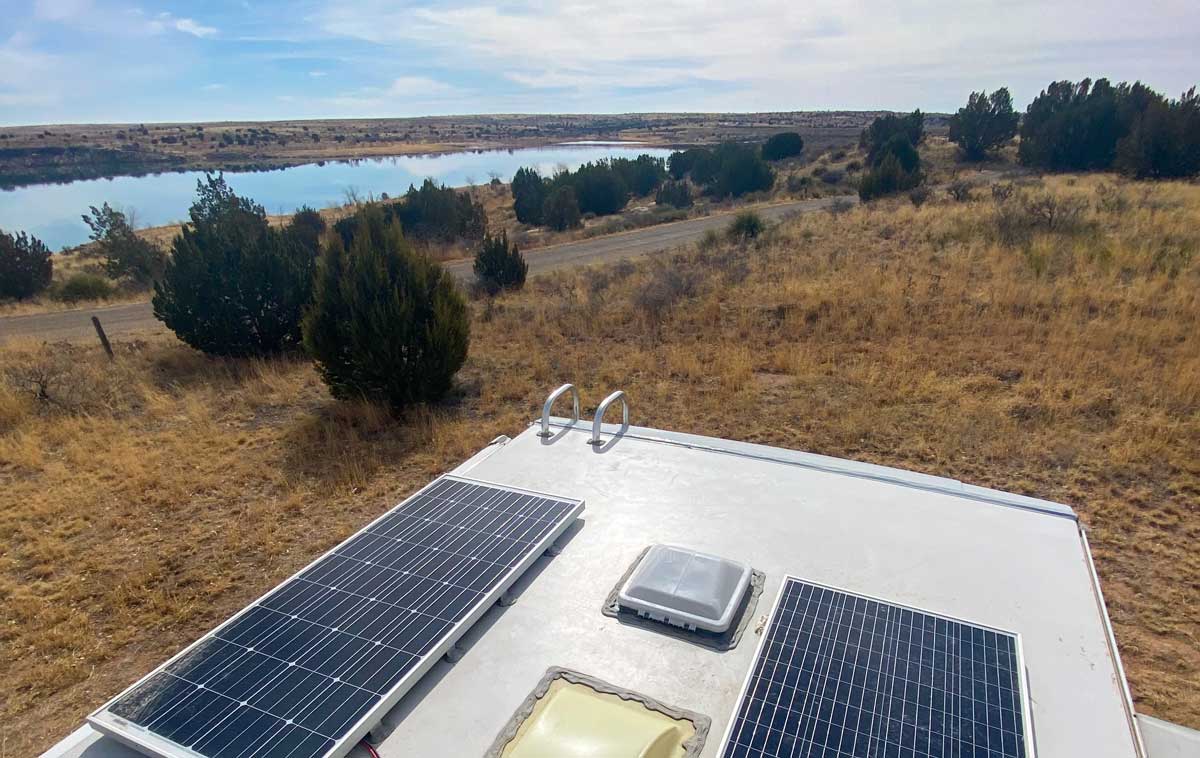
However, if your goal is to boondock with more amenities or even work remotely, you may need to power things such as a data booster, computer, microwave, kitchen gadgets, TV, and more.
Options for Power and Starting Simple
Solar solutions such as upgraded truck alternators, large solar power installations, and lithium batteries can get expensive quickly. If you are just getting started with RV boondocking, consider starting with a smaller investment and see how you manage your power.
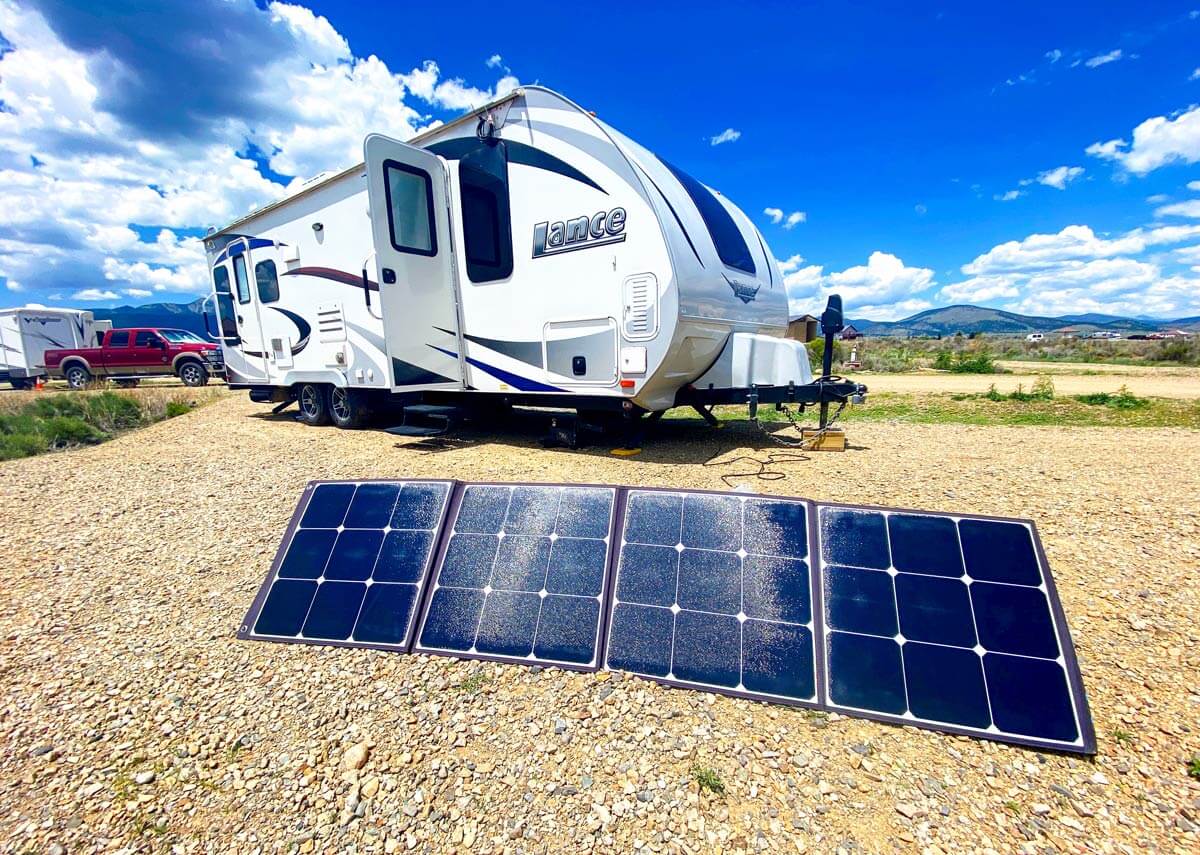
Power Stations
A power station with portable solar panels for running and charging essentials may work great for you. These setups don’t require you to install anything. Use the power station to charge or run anything you need while boondocking.
There are many different size power stations, but most come with a couple of AC outlets and multiple USB ports. Once you run the battery down, recharge by setting up the solar panels.
Generators
You can run a generator during the day to recharge your RV batteries or even run an AC unit. There are a lot of quality generators on the market. Brands with good reputations include Honda and Yamaha. Harbor Freight’s Predator is also a great budget generator.
Ideas for Getting the Most Out of Your Power Setup
- Use small portable battery banks to charge electronics at night or when your main batteries are low.
- Consider purchasing a DC-powered version or 12-volt charger for electronics you often use, and avoid running an inverter. For example, you might want a 12-volt TV, laptop DC charger, etc. We have a vacuum that came with an AC and DC charger, and some manufacturers even make 12-volt air condition units.
- If you are using solar, remember to charge and run things mid-day so your battery bank can recharge before sundown.
2. Conserve Water
Water is the resource that usually sends boondockers back to civilization.
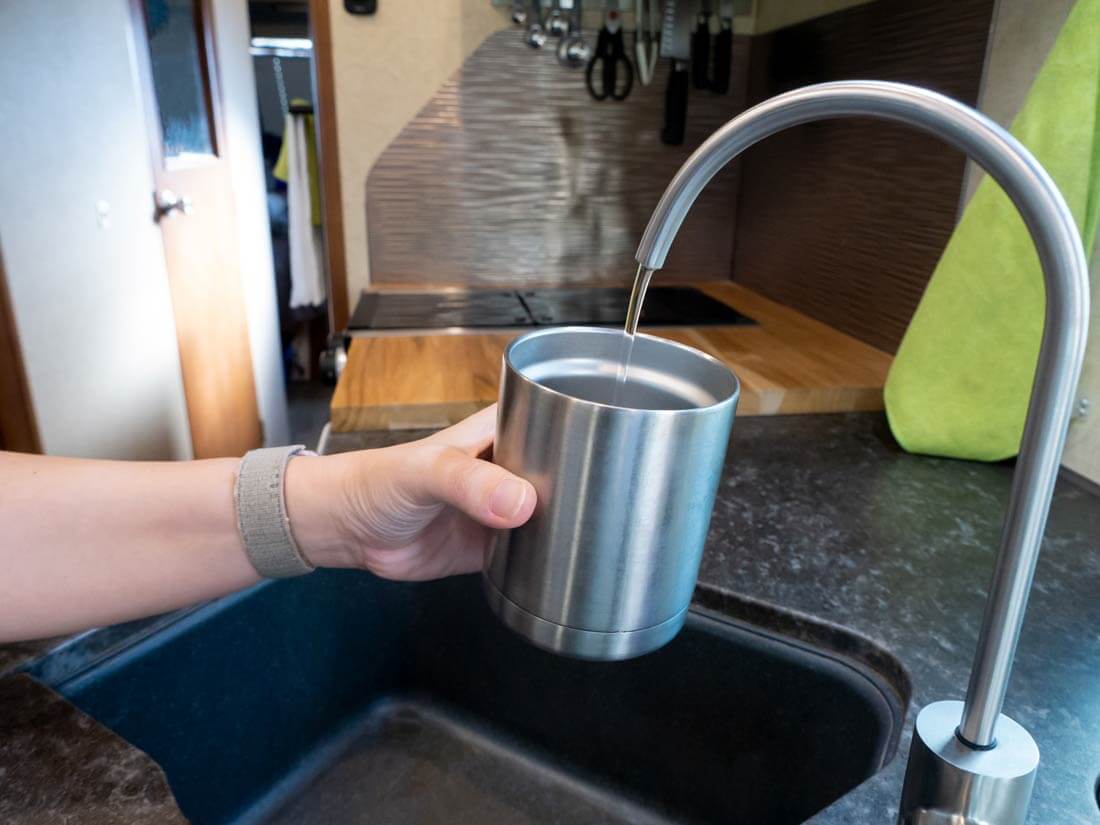
Your water usage and the size of your freshwater tank will determine how long you can stay in your boondocking spot. Once your water runs out, you can either move the RV to find a refill for the tank or fetch fresh water in another vehicle using portable jugs or a water bladder.
Boondocking Tips and Tricks to Save Water in the Kitchen
- USE A COLLAPSIBLE TUB. Place a collapsible tub in the sink to catch water. If you run a little water here and there, catch it in the tub and use it later to wash dishes.
- CHOOSE ONE-POT MEALS. When planning what you’ll be eating while boondocking, opt for one-pot meals, campfire cooking, or grill and griddle recipes to cut down on dishes.
- DON’T LET FOOD DRY ON DISHES. Wipe dishes with a towel shortly after meal time. I usually grab an already dirty paper towel to wipe off any messy dishes that will ruin the basin water.
NOTE: Many RVers will use paper plates and cutlery when boondocking – we try to avoid single-use paper and plastic, so we still wash dishes. It also saves on storage and trash. See more sustainable options by checking out our best zero-waste swaps for small spaces.
Boondocking Camping Tips to Save Water in the Shower
- TAKE A ‘NAVY SHOWER’. You’ll want to go longer between showers when you are boondocking, but when you do shower, take a navy shower. This term describes the process of turning the water off while you lather up. We like to use these large camping wipes in between showers to freshen up.
- DON’T WASH YOUR HAIR. Especially if you have long hair, go as long as possible without washing it. You can use dry shampoo in between washings. Also, get your hair accustomed to not being washed. Everyone’s hair is a little different, but usually, you can train your scalp to produce less oil by slowly increasing the time between washes. When you skip hair shampoo and conditioning, you can cut your water usage by a significant percentage.
- USE A WATER-SAVING SHOWERHEAD. Invest in a water-saving showerhead such as this one from Oxygenics. These showerheads provide a lower gallon-per-minute rate while increasing water pressure. A button on the showerhead to turn the water to a trickle makes it easier to take a navy shower.
- CATCH UNUSED SHOWER WATER. Use a collapsible tub to catch the shower water that runs while waiting for the heated water. Use this water to flush the toilet or wash dishes.
Thoughts on Drinking Water
You can bring extra drinking water to save water in your tanks. Purchase gallon jugs or use a water dispenser and bottle exchange at places like Walmart.
We personally don’t like the plastic waste of buying packaged water, so instead, we transfer extra water stored in our collapsible water totes to our water tank. We use an Acuva water purifying system installed under the kitchen sink combined with an exterior ClearSource water filtration system to provide clean drinking water.
3. Research Boondocking Camping Spots
Using boondocking apps is a great way to find the best off-grid camping sites.
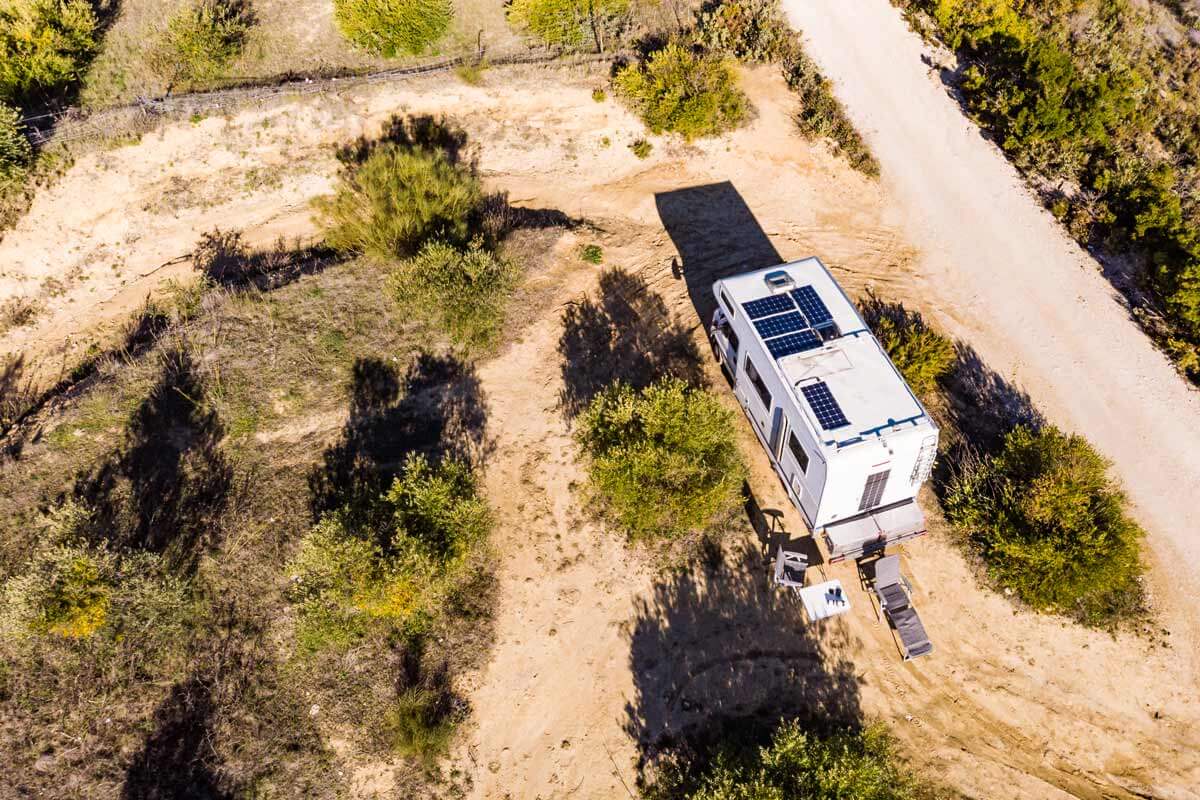
RV Boondocking Apps
Below are a few suggestions of apps that will assist you with finding boondocking near you or other locations.
- The Dyrt (we use the pro version)
- Campendium (we use the Roadpass Pro Membership)
- AllStays
- iOverlander
NOTE: If you are working remotely or cellular service is essential, the Dyrt Pro app and the Campendium Roadpass Pro Membership feature overlay maps for the big three mobile carriers to see what is available in the area quickly.
Make sure to read reviews of potential boondocking sites. Take note of what reviewers say about the road conditions to get to the site, the turn-around radius, the size of the spots, and how crowded the locations can get during busy seasons.
Scout Out Your Site
Here are a few options for scouting out potential boondocking sites.
- Use Google Satellite View to look at the landscape before you get to your site. You can even use it to get a rough measurement of the site.
- Once you arrive, you can scout ahead if you have two people and a toad (a vehicle you tow behind your motorhome) or a bike. One person can travel the road to the site in the extra car or on a bike and communicate by radio or phone with the person driving the RV regarding the road and site conditions.
- Park your RV in a more accessible overnight spot and use the next day to scout out boondocking sites in the surrounding area in the tow vehicle or toad. This is a good tactic if you plan to camp in the area for an extended period.
We’ve even heard of RVers using drones to scout ahead. Just make sure drones are allowed in the area before using this method.
Social Media for Research
Lastly, social media is a great way to find spots visited by other RVers.
Searching Pinterest is an excellent way to find spots in a particular state or area.
If you follow any avid boondockers on Instagram, check out their posts and see where they’ve been or what they would recommend. Most people are happy to share their favorite spots through direct messages.
Boondockers Welcome
Another option for finding free remote camping spots is purchasing an annual membership for Boondockers Welcome. This program gives you access to over 3,000 hosts throughout North America. These are all on private property and can provide access to some remote locations where you wouldn’t usually park an RV.
READ NEXT: For more information on moochdocking, check out What is Moochdocking? Free Camping & How to Do It.
4. Stock Up
Before heading out on a boondocking trip, make sure you restock and fill up on everything you might need.
Checklist for Getting Ready to Boondock
If you are full-time boondocking, stocking up can be a little trickier.
Many RVers that boondock a large percentage of their time will book an RV park or campground with amenities every couple of weeks to refill their water tanks, grocery shop, dump their tanks, and grab a hot shower.
5. Manage Grey and Black Water Tanks
Being conservative with your black and grey tanks is another boondocking necessity.
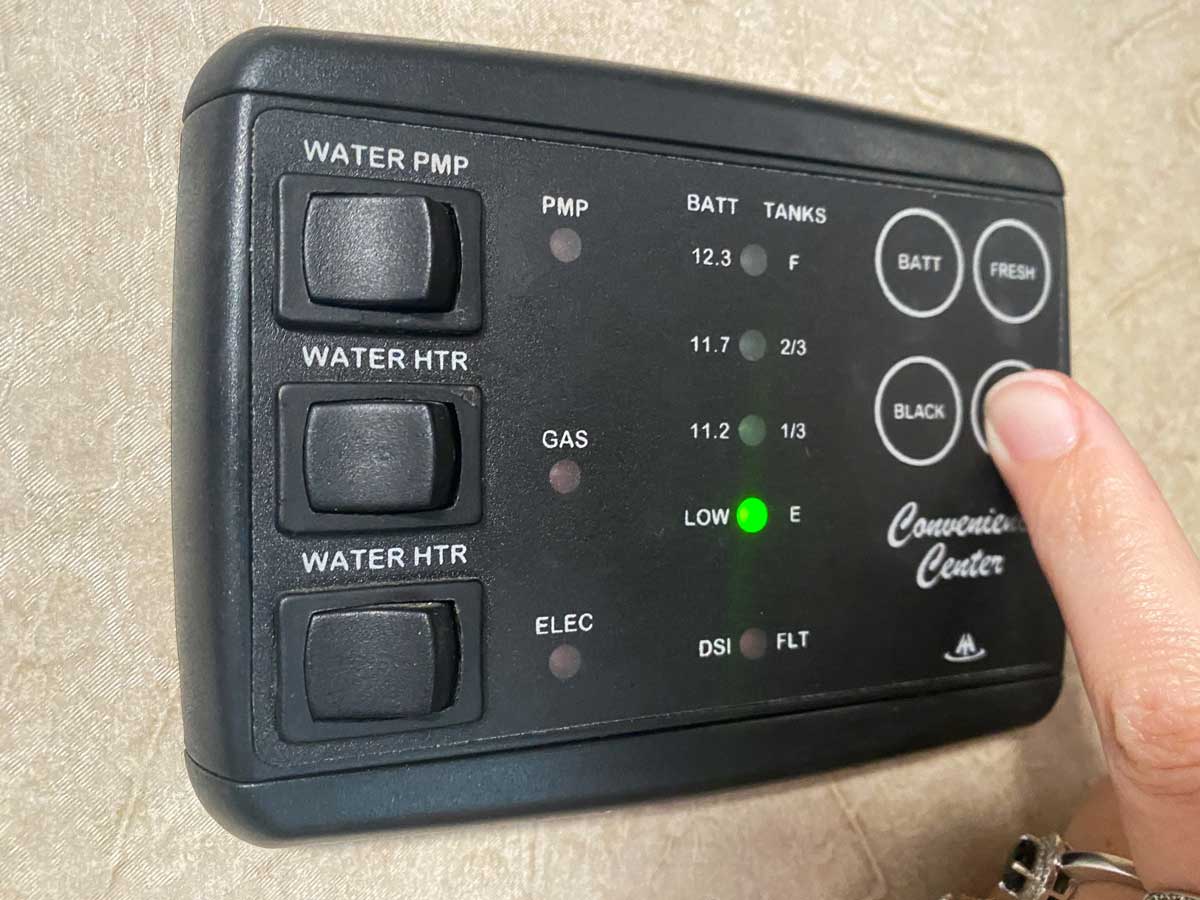
Tank size is one of the only things you really need to be aware of when shopping for a boondocking RV. Switching out your tanks isn’t an option at a later date, so you need to have decent-sized tanks upfront.
If you have a travel trailer with a small black tank or wish to do long-term boondocking, you can avoid taking your trailer to the dump station by using a portable black tank.
How to Conserve Space in Your Grey Tank
- CATCH SINK WATER. A great boondocking hack is to catch your sink water in a small collapsible tub and empty it outside your RV.
- CATCH SHOWER WATER. Shower while standing in a collapsible tub to catch most of your shower water. Toss the water out, but make sure to use green options for soap and shampoo.
- SHOWER OUTSIDE. Another way to save space in your grey tank is to use a solar shower for bathing outside. If you are interested in this option, you can purchase some great outdoor shower stations for privacy.
PRO TIP: Make sure to use biodegradable soap when using either of these strategies.
How to Conserve Space in Your Black Tank
- USE PUBLIC TOILETS. Whenever you have the chance, use other toilet options. Dry camping spots and some boondocking locations will have vault toilets. If you’re out exploring for the day, use a public restroom before returning to the RV.
- USE NATURE. If you’re in a remote location, use the bathroom outside. We realize this isn’t as easy for women as men, but the GoGirl (also known as a pee funnel) works well if you’re up for getting a little adventurous. The Kula Cloth is another excellent product for peeing outdoors!
Alternatives to Black Tanks
If you are looking for options to avoid a black tank altogether, there are a few alternatives below.
- COMPOSTING TOILET. This option allows you to manage waste without a dump station. The liquid and solid compartments are disposed of separately. A composting toilet can be more challenging, but many RVers love it. They also help conserve water since no water is required to use them. Two popular composting toilet options are Nature’s Head and Air Head.
- INCINERATOR TOILET. This option is exactly what it sounds like. These toilets use propane, gas, or electricity to literally burn up your waste. They are relatively expensive compared to other options, but we are interested in seeing how these products progress. Read more about incinerator toilets.
6. Staying Cool While Boondocking
When you’re off-grid, staying warm usually isn’t a problem. RV heaters typically run on propane, or you can purchase a small propane heater.
However, staying cool in hot months is usually a big concern for boondocking RVers.
Running AC in an RV Off-Grid
Running a typical RV air condition unit while boondocking usually requires a generator.
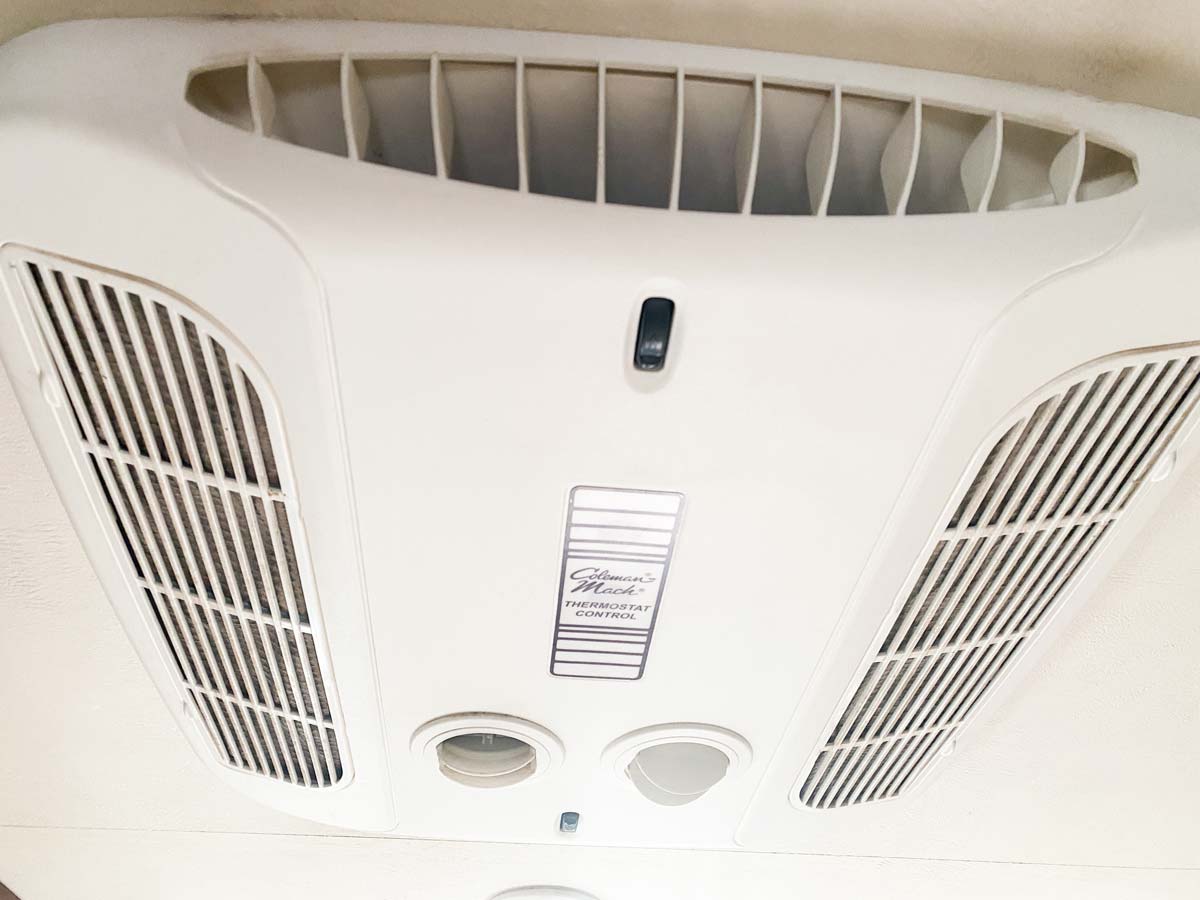
Some large RV solar setups (think somewhere around 1.5 – 2kws) can run an air conditioner during the day but might still require a generator to camp in hot conditions (especially if there’s more than one AC unit). These setups also need a large lithium battery bank, a 3,000-watt inverter, and a soft-start for the AC unit.
The best way to boondock is to avoid extreme temps and follow the weather. You may also want to invest in a generator to power your AC on and off throughout the day.
Ideas for Keeping Your RV Cool
Even without the ability to power an air conditioner, you can still find other ways to stay cool in your RV. Here are a few ideas.
- Use Reflectix on windows in your RV
- Park where the afternoon sun is facing the awning on your RV, and use the awning to shade your home
- Use multiple high-quality roof vent fans to circulate air through the RV
- Open windows on each side of the RV to create a cross-breeze
Boondocking in hot temps will always be challenging, but preparing yourself to manage the heat and moving with the seasons will allow you to continue enjoying your time in remote locations.
7. Create a Relaxing and Functional Outdoor Space
One of the best things about boondocking is enjoying the beautiful, remote camping atmosphere right outside your door. Creating an outdoor setup to enjoy that space is a great way to elevate your boondocking experience.
Outdoor Decor and Gear for your RV Space
- Outdoor camping rug
- Solar-powered fairy lights or multi-colored light
- Comfy camping chairs
- Wood fire pit (we love our Solo Stove) or propane fire pit
- Outdoor kitchen or appliance for outdoor cooking (we have a cast iron griddle that fits on top of our Solo Stove, a lot of RVers love the Blackstone grill)
- Foldable table or something that can double as a table, such as a cooler
- Portable pop-up tent or other netted outdoor space where you can get away from the bugs (we love our CLAM)
Investing in a few items that will make your space more relaxing allows you to take full advantage of the natural beauty at your remote camping spot.
READ NEXT: Check out our fun and functional ideas for RV campsite setups.
8. Make Smart Choices When Meal Planning
Cooking and cleaning in the kitchen are two of the most significant uses of fresh water when you’re boondocking. It can also be a substantial drain on power, depending on what kind of cooktop and kitchen appliances you are running.
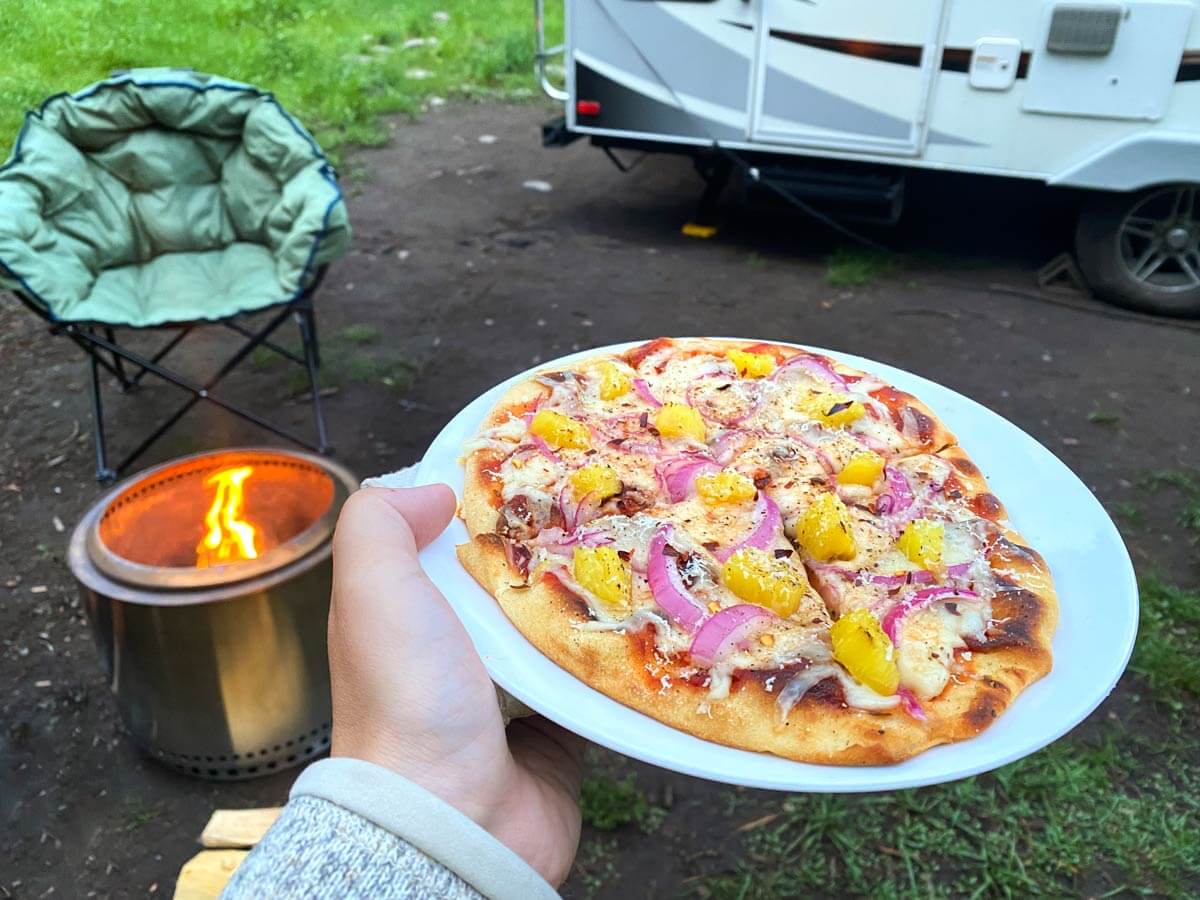
A helpful boondocking tip is to meal prep ahead so you won’t have to worry about water and power usage when cooking.
An ideal boondocking meal might look something like this:
By no means is this a strict guide. Just a few tips to get you started!
Types of Cooking Power and Fuel
Once boondocking, using propane instead of an induction cooktop or a microwave is typically the more efficient way to heat food. Induction cooking is excellent for saving propane but requires a lot of power.
You could also opt for a small wood-burning camp stove to conserve propane.
READ NEXT: For more on meal planning, outfitting an RV kitchen, and storing food, check out our 5 Tips to Master Cooking in an RV.
9. Managing Your Trash
Another boondocking tip is to think ahead and minimize trash. When you’re off-grid, there probably won’t be a place close by to dispose of garbage, and when left outside, it can attract wildlife.
Here are a few tips to keep your waste bin from filling up while wild camping.
How to Reduce Camping Trash
- GET RID OF FOOD PACKAGING: When stocking your pantry for boondocking, get rid of extra packaging. Throw out cardboard boxes, plastic bags, styrofoam packaging, etc. Store grains and baking supplies in reusable bins, meat in reusable plastic containers, and take sodas out of the cardboard boxes.
- PREP VEGGIES & FRUIT: Get rid of extra peelings, stems, and skins. Or freeze your vegetable scraps and make homemade broth!
- ORGANIZE YOUR TRASH CAN: Although it may sound silly, you can put more trash in your bin if you organize it a bit. Pack dirty plastic baggies with food scraps, stuff smaller trash in empty food cans, crush soda cans, and anything else to maximize space.
- BUY ITEMS WITH PAPER PACKAGING: If you buy things with packaging made of paper rather than plastic, you can burn the paper packaging. Just be aware of plastic coatings, as they may produce toxic fumes.
- STORE “CLEAN TRASH” SEPARATE: For items such as rinsed wine bottles, egg cartons, cardboard, and empty glass bottles, store them in a separate location to save room in the trash can.
A positive of boondocking is it brings us face-to-face with how much trash we create. The more experience you have, the better you’ll become at avoiding unnecessary waste on your adventures.
10. Follow RV Camping Etiquette
All RV boondockers are out to enjoy themselves and have a nice time. However, there are still a few rules to follow to avoid disturbing your neighbors.
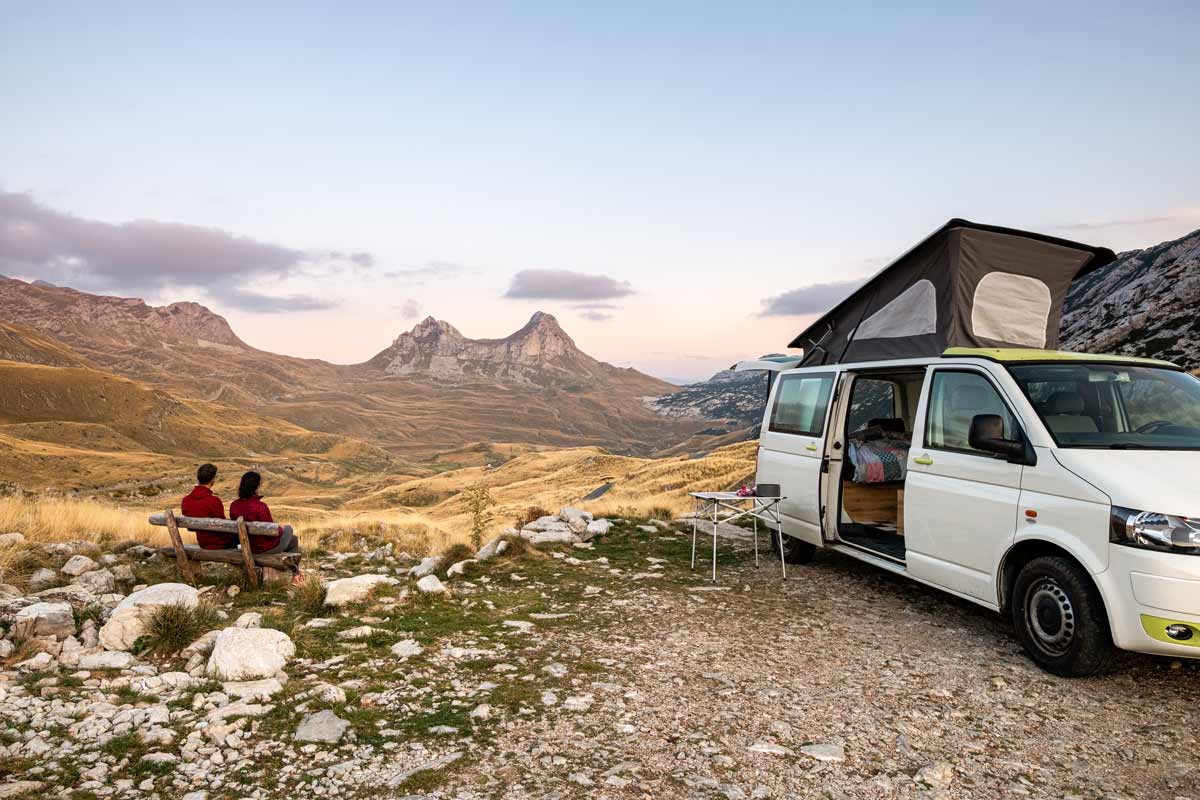
Quiet Hours
Most people boondock for the secluded atmosphere and peaceful environment that nature provides. Nothing kills that vibe quicker than a generator running into the night or a TV blaring from the RV next door.
Quiet hours are generally between 10 pm and 6 am. However, most RVers don’t run a generator past sundown.
5 Tips for RV Boondocking Etiquette
- park in designated camping spots
- give your neighbors some space and avoid parking on top of other RVs
- be aware of light pollution, and don’t leave your outdoor lights on unless necessary
- leave your campsite cleaner than you found it
- clean up after your pets
Learning How to Boondock in an RV
The best RV dry camping tip is to practice with a safety net. Whether in your driveway or at a campground with hookups, try living as if you are boondocking.
See how much power that kitchen blender uses. If it pulls too much from your battery bank, do you really need it? Or is there an alternative, such as an immersion blender, that draws a fraction of the power?
The best way to find out is to go about a typical day and monitor your power and water usage. You can always hook up the water and power if you get in a tight spot on a trial run.
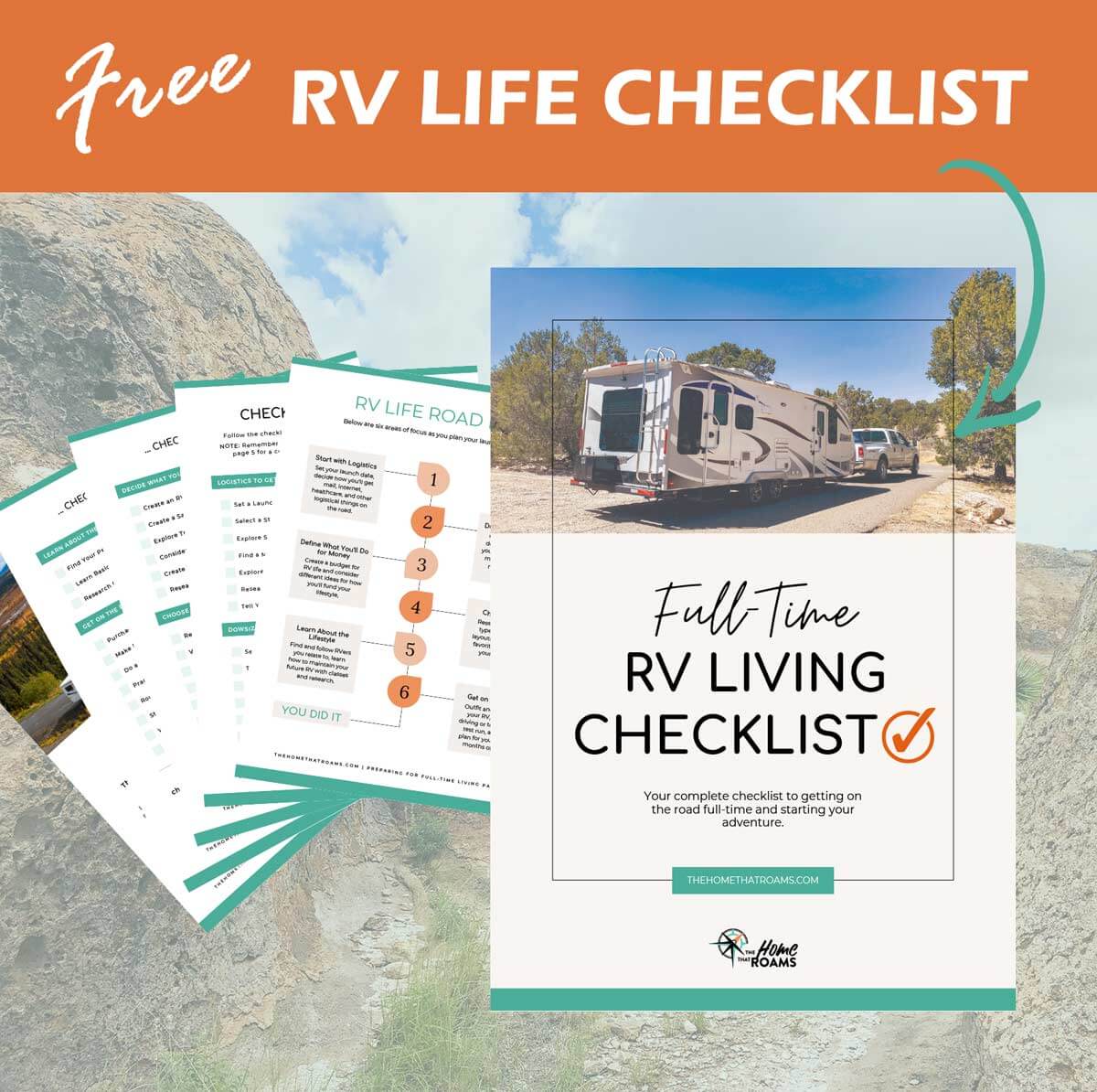
Your Guide to Launching RV Life
Road Map & Checklist – Start Now!
Unsubscribe at any time. View our privacy policy.
With a bit of practice and the ten tips above, you’ll be able to camp off-grid like a pro and enjoy all the benefits of it!
Want to learn more about how to go full-time RVing on a budget?
Find more tips for RV living on the cheap, including finding deals on campsites, calculating fuel costs, and more – view our complete guide.
Like this post? Save it on Pinterest for later.
